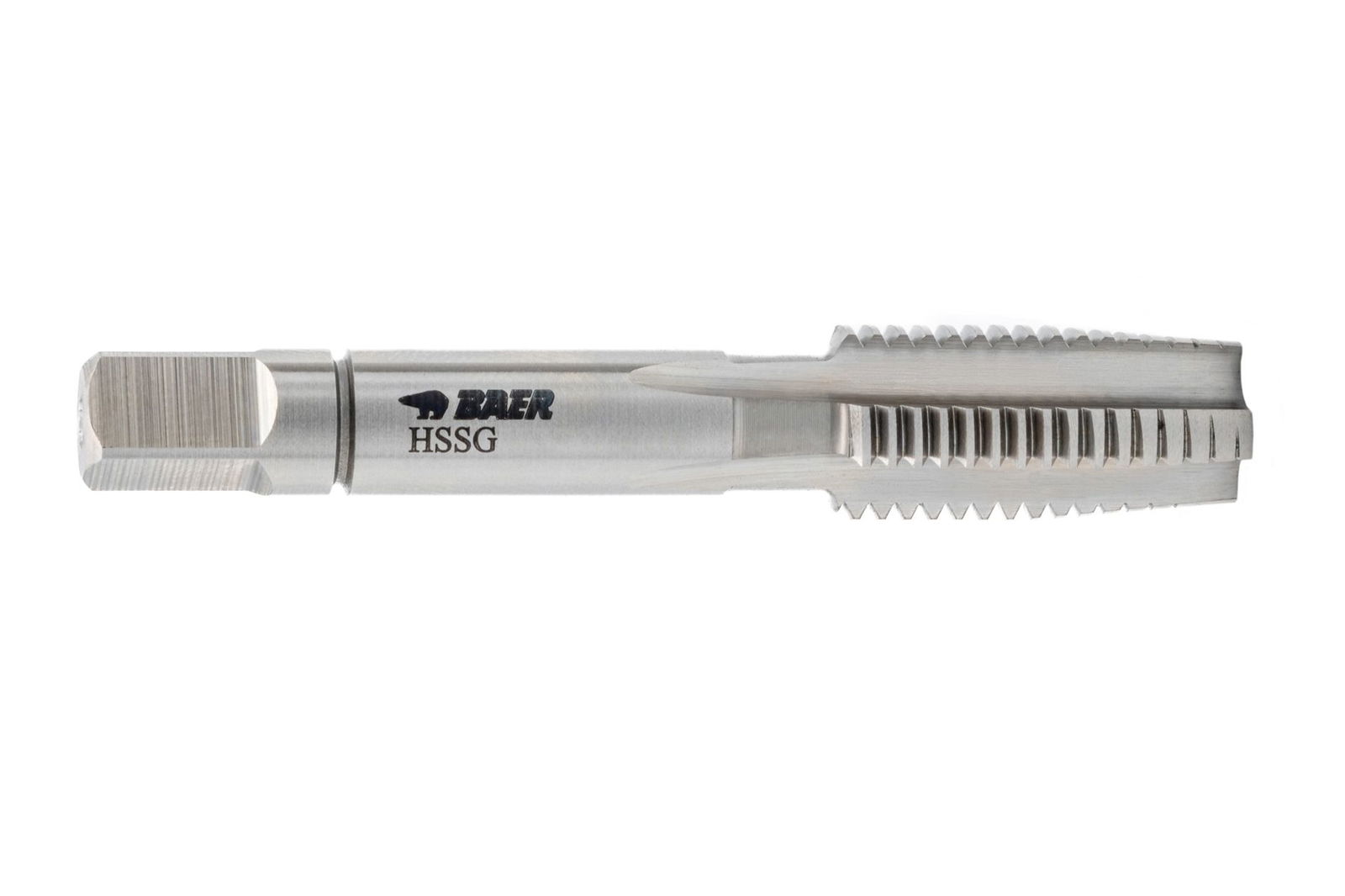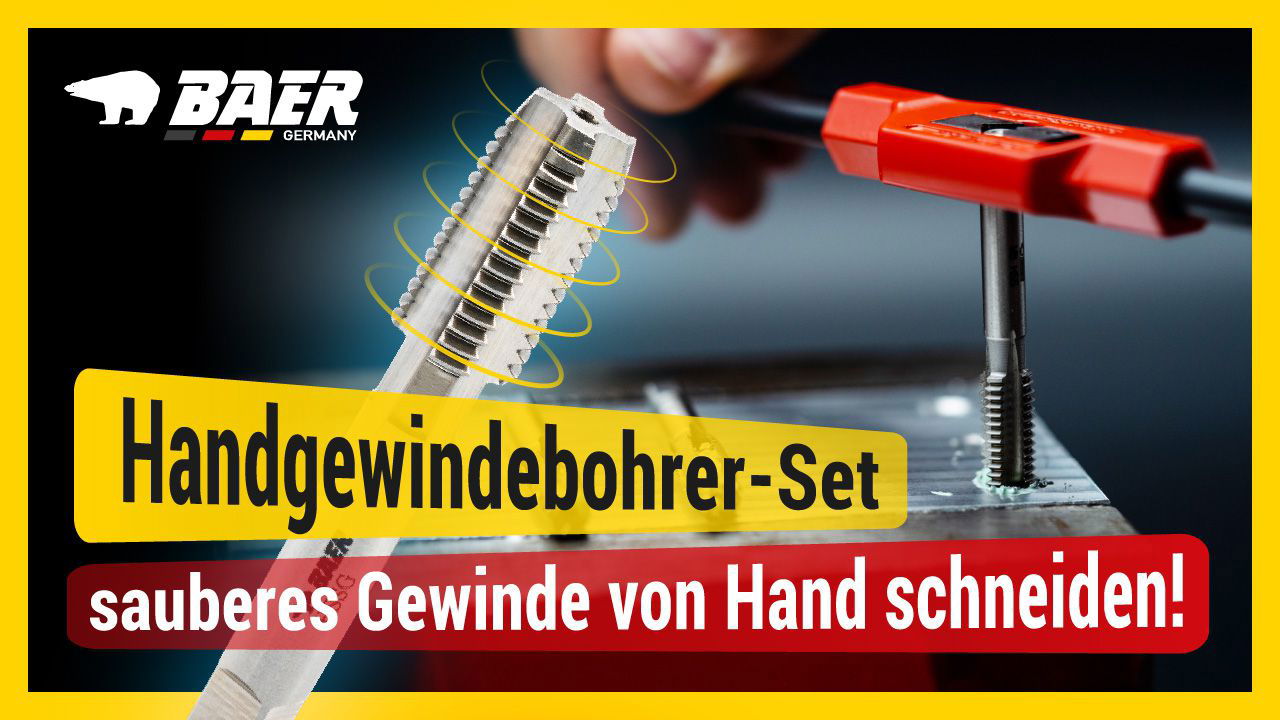BAER HSSE Hand Tap Taper (No. 1) G (BSP) 3/4 x 14
In stock
BAER HSSE Hand Tap Taper (No. 1) G (BSP) 3/4 x 14
The hand tap taper tap (No. 1) enables you to pre-cut a thread. The advantage of pre-cutting a thread is that the cutting forces on the subsequent finishing tap (No. 3) are reduced. The taper tap (No. 1) is marked with a ring and removes approx. 65 percent of the thread profile. Because no complete thread profile is cut, the thread is not yet usable. Only when the finishing tap (No. 3) completes the thread in the last process is it fully usable. By dividing the work between two or three taps, it is easier to cut a straight and clean thread by hand.
Compared to the machine tap, the hand tap has a short shank. This allows you to cut internal thread by hand without jamming and can be operated with tap wrenches, tool ratchets or other holding tools with square drive.
The thread can be cut in a pre-drilled core hole.
Dimensions
| Diameter |
3/4 |
|---|---|
| Nominal diameter in inches |
1,041 |
| Nominal diameter in mm |
26,44 |
| Pitch |
14 |
| Pitch in mm |
1,814 |
| Dimension |
G (BSP) 3/4 x 14 |
| Square |
16 mm |
Characteristics
| Product group |
Screw taps |
|---|---|
| Product type |
Hand tap sets |
| Thread standard |
G (BSP): British Standard Pipe Thread according to DIN ISO 228 - Cylindrical pipe thread |
| Tolerance |
medium |
| Direction |
Right |
| Standard |
DIN 5157 |
| Tensile strength at room temperature |
up to 1200 N/mm² | 38 HRC |
| Material |
HSSE bright |
Technical information – Screw taps

24.5 mm

Through hole and blind hole up to 2 x D

Form A straight fluted

6-8 threads

Rarely occurs. Chips remain in flutes.

External cooling and lubrication

HSSE bright

up to 1200 N/mm² | 38 HRC

medium
Applications
- Difficult to machine materials
- Steels up to 1200 N/mm²
Examples of applications
- Inch thread or Whitworth thread in the sanitary sector
- G-pipe pipe thread
- Fittings, connectors, nipples, threaded fittings for water pipes, sanitary threads, water threads
- Double nipples and double pipe nipples
- Angle connection
- Pipe threaded connections
Technical drawing

| D1 |
G (BSP) 3/4 x 14 |
|---|---|
| D2 |
20 mm |
| L1 |
90 mm |
| L2 |
22 mm |
| Diameter |
3/4 |
| Square |
16 mm |
Application – Sample materials
| General construction steels | |
|---|---|
| 1.0035 | S 185 (St 33) |
| 1.0036 | S 235 JRH |
| 1.0039 | S 235JRG1+CR |
| 1.0060 | E 335 (St 60-2) |
| Free-cutting steels | |
|---|---|
| 1.0718 | 11SMnPb30 |
| 1.0721 | 10S20 |
| 1.0726 | 35S20 |
| 1.0728 | 60S20 |
| Case-hardening steels | |
|---|---|
| 1.0401 | (C15) |
| 1.7016 | 17 CR3 |
| 1.7131 | 16MnCr5 |
| 1.5919 | 15CrNi6 |
| Quenched and tempered steels unalloyed | |
|---|---|
| 1.0402 | C 22 |
| 1.1151 | C22E (Ck 22) |
| 1.0503 | C 45 |
| 1.1191 | C45E (Ck 45) |
| Cast steel | |
|---|---|
| 1.5681 | GS-10 Ni 19 |
| 1.6760 | GS-22 NiMoCr 5 6 |
| Quenched and tempered steels alloyed | |
|---|---|
| 1.1133 | 20Mn5 |
| 1.5710 | 36NiCr6 |
Further information
- G (BSP) - British Standard Pipe DIN ISO 228 - Cylindrical pipe thread
- Whitworth Pipe Thread
- Designations, geometries and definitions on taps
- Thread tolerances of the internal thread
- Internal thread and core hole dimensions
- Tap Chamfer forms
- Comparison inch-mm
- Surface treatments on tapping tools
- Cutting speeds and lubrication/cooling
- Information about tapping
- Material table
Safety instructions
Login




